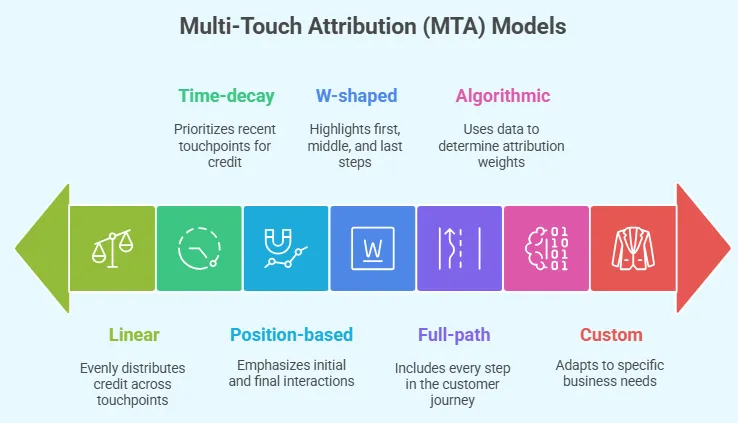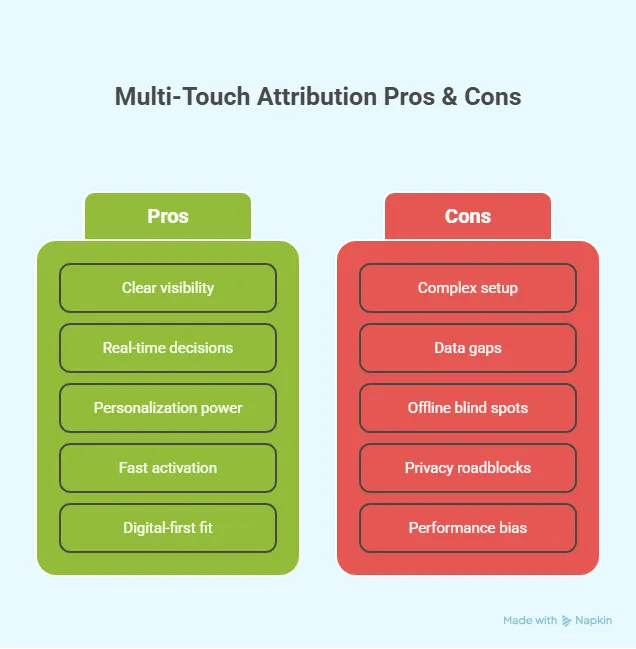






















You’re juggling fragmented channels, stricter privacy rules, and shifting consumer behavior. And the data never lines up as neatly as dashboards suggest.
Making sense of messy customer journeys and proving return on investment has never been harder.
Attribution modeling should help. But even seasoned teams know the limits.
Multi-Touch Attribution (MTA) promises real-time, touchpoint-level clarity. Marketing Mix Modeling (MMM) gives the big-picture view across channels, budgets, and external factors.
Both are valuable, and both come with real constraints.
The question is not “Which one is best?”. It’s how to apply them in your world, with inconsistent data, identity gaps, offline media that resists tracking, and constant pressure to prove media ROI.
In this blog, we’ll cover:
P.S. Struggling to prove media ROI, align your marketing spend with business insights, or compare attribution models across channels? Fieldtrip has you covered. We bring strategy, creative, media buying levers, and advanced marketing analytics together in one system built for modern marketing teams. Let’s talk to explore how we can drive measurable growth.
Multi-Touch Attribution (MTA) analyzes individual customer interactions across digital channels to assign credit to each touchpoint.
Marketing Mix Modeling (MMM) evaluates overall marketing effectiveness using aggregated data, linking spend to business outcomes across both online and offline channels.
MTA Overview
MMM Overview
When to Use Each
Key Takeaways
As you may know, Multi-Touch Attribution (MTA) spreads credit across multiple touchpoints instead of letting the first or last click take all the glory. That means a customer sees a Facebook ad, later searches on Google, clicks through, and finally converts after engaging with your email newsletter. Each of those steps gets some credit.
The goal is to give you a clearer picture of the customer journey.
But in reality, how useful MTA is depends on the quality of your tracking setup, the identity resolution across devices and platforms, and how resilient your data is in today’s privacy-restricted environment.
If you’ve ever seen retargeting ads hog more credit than they deserve, you know exactly what this looks like.
As Sergio Alvarez, Forbes Councils Member, puts it:
“If you’re still measuring sales attribution based on the last place your customer clicked before converting, you’re missing out on valuable information. Attribution has evolved, and in a brave, new, data-driven world, a multi-touch model can be the key to deeply understanding your customer and replicating sales.”
In practice, MTA takes a bottom-up approach. It relies on user-level data to connect the dots across digital media and assign value to each touchpoint in the journey.
The main advantage is rapid feedback. You get near real-time insights that let you reallocate ad spend, adjust targeting, or test creative while campaigns are live.
Of course, that rapid feedback is only useful if your data feeds are clean and you can resolve identities across devices and platforms, which isn’t always simple.
Besides, any useful optimization depends on stable identifiers, clean-room joins, and lift tests that separate correlation from causal impact.
And here’s the catch: MTA doesn’t natively support probabilistic matching. That means cross-device tracking can quickly break down unless you layer in identity resolution tools like LiveRamp or GA4 signals.
However, GA4 isn’t a full identity resolution layer. It can supplement, not solve. And LiveRamp is useful, but more 2020–2022 focused.
We advise you to patch this gap with clean rooms (e.g., Google PAIR, Amazon Marketing Cloud) and first-party data enrichment. These methods allow compliant cross-device joins without leaning solely on cookies or device IDs.
Side note: For advanced teams, MTA is not just “spreading credit.” It requires identity resolution, controls for ad overlap, and guardrails against retargeting bias. That way, your spend doesn’t drift toward the last few touches that piggyback on demand rather than create it.
You’ve probably tested different MTA models already, and you know each one tells a slightly different story:

So why do performance teams still lean on MTA? It brings some real advantages when you’re working across messy, multi-channel campaigns.
According to the MMA Global report, about 52% of marketers were already using MTA in 2024, and 57% considered it an essential part of their measurement toolkit. This shows just how valuable it’s become for modern marketing teams.
Let’s see what makes it valuable in practice:
Here’s the caveat: you see how each touchpoint contributes, but only within each model’s rules. And some models may give more credit to certain interactions. That’s why you also need incrementality testing.
Done poorly (with weak identity resolution), you end up with fragmented journeys. Plus, personalization wins only persist when your segments are stable and your measurement excludes selection effects.
As powerful as MTA is, it has some downsides too
Nowadays, we know that identity resolution increasingly depends on publisher networks, clean-room integrations, and opt-in first-party datasets. If your teams don’t control their first-party data, you’re already seeing wider attribution blind spots.

Marketing Mix Modeling (MMM) gives you the big-picture view that MTA can’t. Instead of tracking user-level clicks, it works with aggregated data, total marketing spend, sales outcomes, and external factors like economic conditions or seasonal trends.
However, modern MMM is not a single regression. Mature setups model adstock and diminishing returns. More importantly, they allow time-varying effects because they incorporate external signals like pricing, promos, and distribution constraints.
You’ve probably leaned on MMM when you wanted proof that TV ads, sponsorships, or offline channels are worth the budget. It’s designed to connect all your marketing efforts, across digital and offline media, to overall business results.
MMM is powerful for strategic planning. A few years ago, it wasn’t truly helpful when you were trying to optimize mid-campaign. It’s not perfect now either.
However, new lightweight Bayesian and machine learning variants shorten feedback loops nowadays. They can currently run on 12-18 months of data instead of the old 3-5-year requirement. So, a mid-campaign calibration becomes more realistic.
MMM takes a top-down approach to measuring performance. Instead of tracking individual user pathways, it relies on aggregated data, total ad spend, sales outcomes, and distribution channels. You’ve probably seen it applied with regression analysis or similar statistical methods that uncover cause-and-effect relationships.
From our experience, teams now increasingly use Bayesian MMM or hierarchical models. These work with shorter data windows and give you genuinely credible intervals for decision making. Next, you can use geo-experiments and synthetic controls to validate the model’s lift estimates.
The model shows how shifts in marketing spend influence key performance indicators like sales, leads, or brand awareness. It also accounts for external variables you can’t ignore, such as seasonal trends, economic conditions, or even weather patterns that change consumer behavior.
Because it spans both digital and offline channels, from search ads and social media to TV ads, billboards, and OOH, MMM gives you a broad, executive-level view of marketing impact.
That’s why it’s mostly used for long-term planning, budget allocation, and media mix modeling, even if it doesn’t help much with mid-campaign tweaks.
MMM has made a strong comeback, partly because privacy regulations crippled user-level tracking and forced teams to find alternatives. Cloud-based MMM platforms and open-source toolkits (like Meta’s Robyn, Google Meridian) have lowered the barrier, letting marketing and finance teams run models without a PhD in statistics.
That’s why over half of US marketers were using MMM in 2024, and about 30% said it’s the best way to uncover the true drivers of business value.
Let’s see why so many teams still rely on it:
MMM is powerful, but you’ve probably felt the pain points that come with it:

Now that we’ve broken down both approaches, let’s put them side by side. Here’s a quick comparison of Multi-Touch Attribution (MTA) vs Marketing Mix Modeling (MMM) so you can see the key differences at a glance.
So, which model should you actually go with? As we have said earlier, there’s no one-size-fits-all answer. The “best” option really depends on your goals, the kind of data you have, and the resources at your disposal.
Let’s break it down by key factors:
If you need campaign-level insights to tweak ads, creatives, or media spend, MTA is your pick. But if you want a strategic, high-level view that connects marketing efforts with overall business outcomes, MMM is the smarter choice.
How fast do you need answers? MMM is better when you’re looking at medium-to-long-term trends, like understanding how seasonal shifts or economic conditions impact your overall marketing performance.
On the flip side, MTA shines when you need real-time optimization. It helps you tweak campaigns, adjust ad spend, and test creative on the fly while results are still coming in.
The type of data you have often decides the model for you. If your team has years of historical, aggregated data across media channels and external factors, MMM will fit perfectly.
But if you’re working with user-level data and want granular tracking of customer touchpoints, from search ads to email newsletters, MTA is the way to go.
Think about how close you need to zoom in. MMM gives you the big picture; it shows how overall marketing spend and external factors shape business outcomes.
MTA, on the other hand, gets down to touchpoint-by-touchpoint clarity. It shows exactly how a Facebook ad, a Google search, or even an email newsletter influenced the customer journey.
The right model also depends on where you spend most of your budget. MMM performs better if you’re running traditional campaigns with offline media like TV ads, billboards, or print. It shows how those channels combine with digital to drive results.
MTA, on the other hand, is perfect for digital-first campaigns. If you live in the world of search ads, Facebook ads, display ads, and email newsletters, MTA gives you the clarity you need.
Each model comes with its own setup demands. MMM usually needs data scientists, advanced statistical modeling, and solid analytical capabilities to make sense of all that aggregated data. It’s resource-heavy but powerful if you’ve got the team.
MTA, on the other hand, leans on strong tracking systems and digital analytics tools. You’ll need the right setup to follow user pathways, capture granular tracking, and keep up with real-time reporting.
Neither model is free, so it’s worth thinking about where the costs land. MMM typically requires a bigger upfront investment in modeling capabilities, data scientists, and long-term analytics projects. MTA usually relies on ongoing costs like tracking technology, attribution scorecards, and third-party attribution tools.
In both cases, you’ll need to weigh the spend against the value of sharper marketing performance measurement and higher media ROI.
CMOs: If you need brand and offline impact, pick MMM with a quarterly refresh. Focus on metrics like aided awareness, share, and pipeline from branded and direct.
CFOs: If the question is payback and CAC control, use MMM to set mix, require MTA lift tests for in-quarter reallocations. Key indicators we recommend you to use are CAC, payback, MER, and forecast error.
Head of performance: If you need creative and audience clarity this week, run MTA with geo or holdout tests. Track incremental CVR, marginal ROAS, and overlap rates.
Most mature teams don’t stop at one model. The future of measurement is hybrid. And you’ve likely felt that pressure already. MTA gives you granular, near real-time tracking across digital campaigns, while MMM delivers the strategic view that ties both online and offline spend to outcomes.
When you combine them, you get speed and context. MTA helps you optimize creative, shift budgets, and cut wasted spend daily. MMM helps you justify big-budget allocations, account for external factors, and defend media ROI in the boardroom.
Of course, this combination also breeds conflict.
MTA might show a channel underperforming in real time while MMM credits it with long-term incremental impact.
That’s why you’ll still need incrementality testing (as we mentioned above), control groups, and causal inference methods to validate results. Identity resolution and data quality remain the make-or-break factors.
Hybrid setups double the resource demands: clean tagging + identity resolution for MTA, plus years of stable spend and external data for MMM. Without the right people and processes, hybrid models risk becoming a patchwork that pleases no one.
But when done right, a hybrid approach bridges the gap between in-flight optimization and long-term planning.
In practice, that might mean testing Facebook ad performance with MTA this week while relying on MMM to guide how much you’ll allocate to TV ads, social media, and search next quarter.
But together, they give you a performance measurement approach that’s far stronger than either model on its own.
Both MTA and MMM models bring unique strengths. And combining them can give you the clearest view of marketing performance.
Whether you’re chasing quick wins or shaping long-term strategy, understanding both models and when to combine them will help you turn marketing spend into measurable growth.
Key Takeaways
If you’re looking to simplify measurement, optimize media spend, or connect attribution models to real business outcomes, Fieldtrip is here to help. We unify strategy, creative, media, and analytics in one system.
Let’s talk to turn your attribution challenges into measurable growth!
Multichannel attribution looks at performance across different marketing channels but may give most of the credit to a single touchpoint. Multi-touch attribution spreads credit across every customer interaction, showing how each touchpoint in the journey contributes to conversions.
Media mix modeling is a narrower version that focuses mainly on paid media performance. Marketing mix modeling is broader. It includes media but also accounts for pricing, promotions, distribution, and external factors like seasonality or market trends.
The classic marketing mix is built around the Four Ps: product, price, place, and promotion. Product defines what you’re offering. Price sets its market value. Place covers the distribution channels that deliver it to customers. Promotion focuses on how you communicate and market the product.
Together, these four elements shape how businesses position themselves and reach their target audience effectively.
There isn’t a single “best” attribution model. Multi-touch attribution works best for digital-first campaigns with user-level data. Marketing mix modeling is stronger for enterprises with offline channels and large historical datasets. Many brands now combine both for a hybrid approach.
Yes, and in fact, that’s becoming the norm. MTA helps you with real-time optimization in digital campaigns, while MMM provides strategic, long-term insights across online and offline media. Together, they deliver a more complete picture of marketing performance.
Yes. Fieldtrip builds hybrid measurement frameworks that connect granular digital tracking with big-picture strategic modeling. This helps you get both real-time optimization and long-term insights without managing separate systems.
Fieldtrip has supported global brands across industries like consumer goods, retail, technology, and finance. Our team specializes in helping enterprises manage complex media spend, measure performance, and align marketing strategy with business growth.